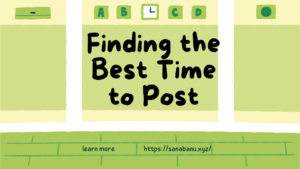Best Time to Post : Optimizing Your Social Media Presence
Optimizing Your Social Media Presence: Finding the Best Time to Post
In today’s digital age, social media has become a powerful tool for businesses and individuals alike to connect with their audience, share content, and build brand awareness. However, with the vast amount of content being shared every minute, it’s crucial to strategize not only what you post but also when you post it. Finding the best time to post on social media can significantly impact your reach and engagement. Let’s delve into some strategies to determine the optimal posting times across various platforms.
Understanding Platform Dynamics
Each social media platform has its own unique user base and peak engagement times. Understanding these dynamics is the first step in optimizing your posting schedule.
- Facebook: Studies have shown that the best times to post on Facebook are typically mid-week between 1 pm to 3 pm, with Thursdays and Fridays being particularly active. However, the ideal posting time can vary based on your target audience’s demographics and behaviors.
- Instagram: Instagram sees high engagement throughout the week, but Mondays, Wednesdays, and Thursdays tend to perform best. For optimal results, aim to post between 11 am to 1 pm, or in the evenings between 7 pm to 9 pm when users are likely to be more active.
- Twitter: Twitter is known for its fast-paced nature, and the lifespan of tweets is relatively short compared to other platforms. To maximize visibility, consider posting during lunch hours (12 pm to 1 pm) or in the late afternoon (5 pm to 6 pm) when users are taking breaks or commuting.
- LinkedIn: LinkedIn is primarily used for professional networking, so it’s no surprise that weekdays, particularly Tuesday through Thursday, are the best times to post content. Aim for mid-morning (9 am to 11 am) or midday (12 pm to 1 pm) slots when professionals are likely to be checking their feeds.
- Pinterest: Pinterest is unique in that its content has a longer lifespan compared to other platforms. Users often browse for inspiration during evenings and weekends, making Saturday mornings and evenings between 8 pm to 11 pm best time to post.
Leveraging Analytics and Insights
While general guidelines can provide a starting point, every audience is unique. Leveraging analytics and insights provided by each platform can help you pinpoint the best times to reach your specific audience.
- Native Insights: Most social media platforms offer built-in analytics tools that provide valuable insights into your audience’s behavior, including when they are most active. Use these insights to experiment with different posting times and measure engagement metrics.
- Third-Party Tools: Additionally, various third-party analytics tools can provide more in-depth analysis and recommendations for your social media strategy. These tools often integrate with multiple platforms, allowing you to streamline your analytics process and make data-driven decisions.
Experimentation and Adaptation
Ultimately, finding the best time to post on social media requires experimentation and adaptation. Don’t be afraid to test different posting schedules and content types to see what resonates best with your audience. Monitor the performance of your posts and be willing to adjust your strategy accordingly.
explore some additional points to consider when determining the best time to post on social media:
- Time Zone Considerations: If your audience spans multiple time zones, consider scheduling posts to accommodate different regions’ peak activity times. Many social media management tools offer features to schedule posts according to specific time zones, ensuring your content reaches the widest audience possible.
- Audience Demographics: Understanding your audience demographics is key to effective timing. For example, if your target audience consists of working professionals, posting during typical work hours might not yield optimal results. Tailor your posting schedule to align with when your audience is most likely to be active and engaged.
- Seasonal Variations: Be mindful of seasonal variations and how they might impact your audience’s behavior. For instance, during holidays or vacation seasons, best post time and engagement patterns may shift. Adjust your strategy accordingly to capitalize on seasonal trends and maintain consistent engagement.
- Content Relevance: The timing of your posts should also align with the relevance of your content. For instance, if you’re sharing timely news updates or promotions, timing is crucial to maximize visibility and engagement. Consider the context of your content and how it fits into your audience’s current interests and priorities.
- Engagement Patterns of Competitors: Keep an eye on the posting patterns and engagement levels of your competitors or similar brands in your industry. Analyzing their activity can provide valuable insights into when your audience is most active and receptive to content. However, remember that what works for your competitors may not necessarily work for you, so use this information as a reference point rather than a strict guideline.
- Mobile Usage Trends: With the increasing dominance of mobile devices, consider how mobile usage trends might influence your posting schedule. Peak times for mobile usage, such as during commutes or leisure time, can be opportune moments to capture your audience’s attention. Ensure that your content is optimized for mobile viewing and engagement.
- Experimentation with Content Formats: Alongside experimenting with posting times, explore different content formats to gauge their impact on engagement levels. Whether it’s videos, images, polls, or infographics, diversifying your content strategy can attract varying levels of engagement at different times of the day.
- Regular Monitoring and Optimization: Finally, don’t set your posting schedule in stone. Continuously monitor your social media performance metrics and be prepared to adjust your strategy based on evolving audience behavior and platform algorithm changes. Regular optimization is essential for staying ahead in the ever-changing landscape of social media.
By understanding platform dynamics, leveraging analytics, and continuously experimenting with your posting schedule, you can optimize your social media presence and maximize engagement with your audience. Remember, there is no one-size-fits-all approach, so stay proactive and responsive to your audience’s preferences and behaviors.
Click to see another interesting blog.
FAQ:
1. Why is the timing of social media posts important?
The timing of your social media posts can significantly impact their reach and engagement. Posting when your audience is most active increases the likelihood of your content being seen and interacted with, leading to higher engagement rates, increased brand visibility, and ultimately, better results for your social media strategy.
Should I post at the same time every day?
While posting consistency is important for maintaining audience engagement, posting at the same time every day may not always be optimal. It’s advisable to vary your posting times and experiment with different schedules to reach a broader audience and accommodate variations in user activity throughout the day and week.
How can I track the performance of my social media posts?
Most social media platforms offer built-in analytics tools that provide insights into post performance, including reach, engagement, and audience demographics. Additionally, third-party analytics tools can offer more comprehensive analysis and recommendations for optimizing your social media strategy.
Can I schedule posts in advance?
Yes, many social media management tools allow you to schedule posts in advance across multiple platforms. This feature enables you to plan and optimize your posting schedule, even during non-peak hours, ensuring consistent content delivery and maximizing audience reach.


